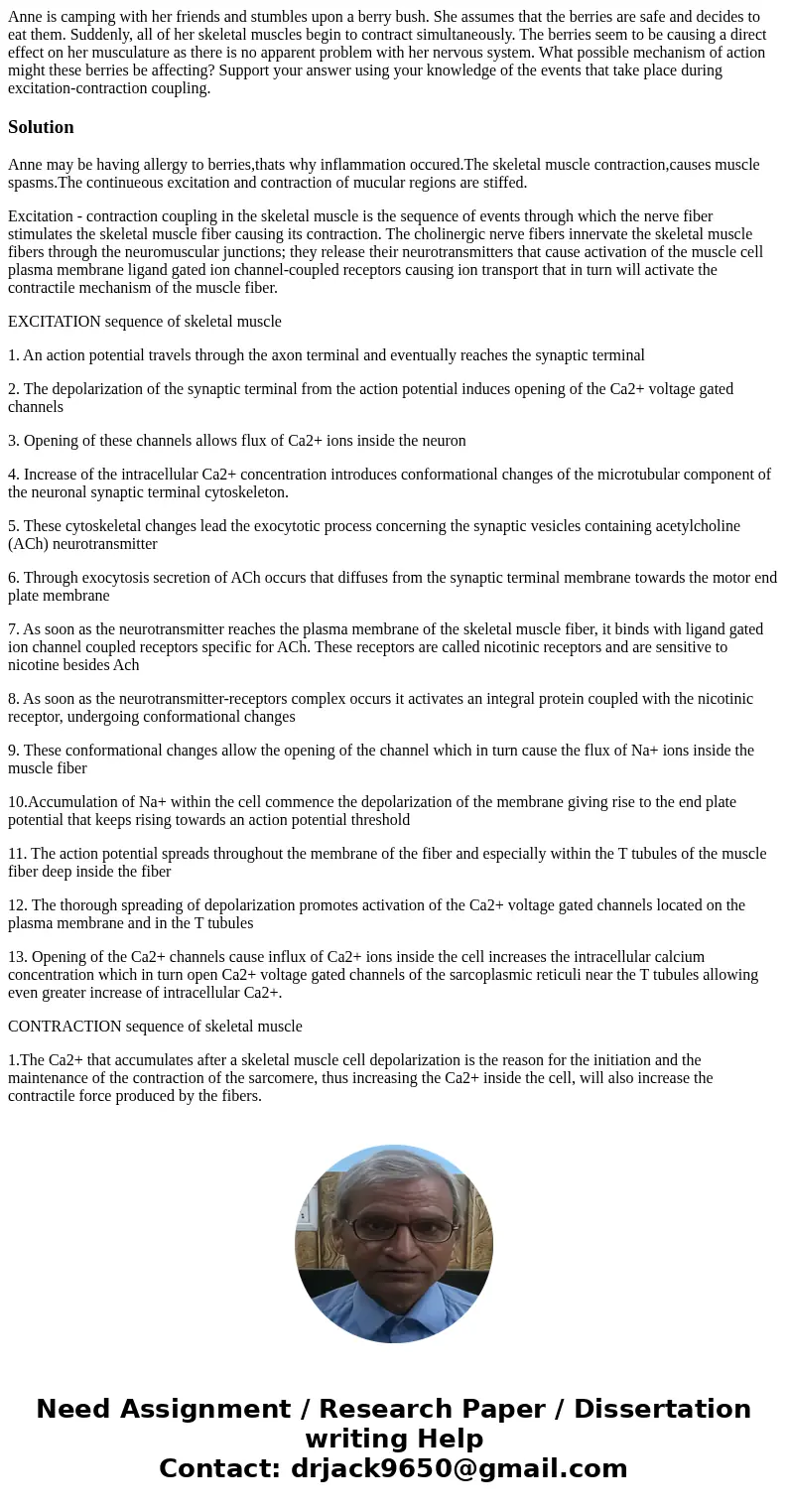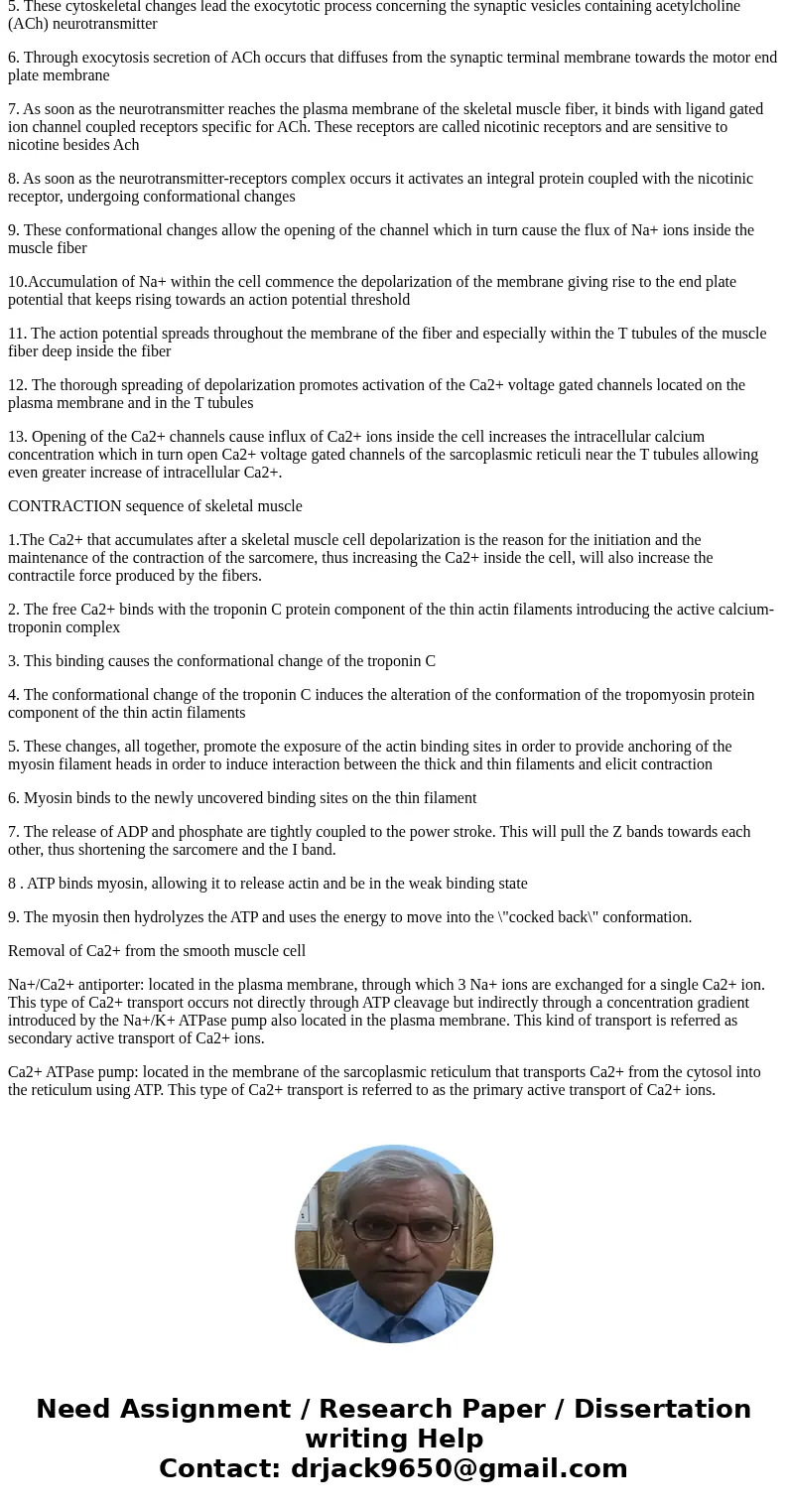Anne is camping with her friends and stumbles upon a berry b
Anne is camping with her friends and stumbles upon a berry bush. She assumes that the berries are safe and decides to eat them. Suddenly, all of her skeletal muscles begin to contract simultaneously. The berries seem to be causing a direct effect on her musculature as there is no apparent problem with her nervous system. What possible mechanism of action might these berries be affecting? Support your answer using your knowledge of the events that take place during excitation-contraction coupling.
Solution
Anne may be having allergy to berries,thats why inflammation occured.The skeletal muscle contraction,causes muscle spasms.The continueous excitation and contraction of mucular regions are stiffed.
Excitation - contraction coupling in the skeletal muscle is the sequence of events through which the nerve fiber stimulates the skeletal muscle fiber causing its contraction. The cholinergic nerve fibers innervate the skeletal muscle fibers through the neuromuscular junctions; they release their neurotransmitters that cause activation of the muscle cell plasma membrane ligand gated ion channel-coupled receptors causing ion transport that in turn will activate the contractile mechanism of the muscle fiber.
EXCITATION sequence of skeletal muscle
1. An action potential travels through the axon terminal and eventually reaches the synaptic terminal
2. The depolarization of the synaptic terminal from the action potential induces opening of the Ca2+ voltage gated channels
3. Opening of these channels allows flux of Ca2+ ions inside the neuron
4. Increase of the intracellular Ca2+ concentration introduces conformational changes of the microtubular component of the neuronal synaptic terminal cytoskeleton.
5. These cytoskeletal changes lead the exocytotic process concerning the synaptic vesicles containing acetylcholine (ACh) neurotransmitter
6. Through exocytosis secretion of ACh occurs that diffuses from the synaptic terminal membrane towards the motor end plate membrane
7. As soon as the neurotransmitter reaches the plasma membrane of the skeletal muscle fiber, it binds with ligand gated ion channel coupled receptors specific for ACh. These receptors are called nicotinic receptors and are sensitive to nicotine besides Ach
8. As soon as the neurotransmitter-receptors complex occurs it activates an integral protein coupled with the nicotinic receptor, undergoing conformational changes
9. These conformational changes allow the opening of the channel which in turn cause the flux of Na+ ions inside the muscle fiber
10.Accumulation of Na+ within the cell commence the depolarization of the membrane giving rise to the end plate potential that keeps rising towards an action potential threshold
11. The action potential spreads throughout the membrane of the fiber and especially within the T tubules of the muscle fiber deep inside the fiber
12. The thorough spreading of depolarization promotes activation of the Ca2+ voltage gated channels located on the plasma membrane and in the T tubules
13. Opening of the Ca2+ channels cause influx of Ca2+ ions inside the cell increases the intracellular calcium concentration which in turn open Ca2+ voltage gated channels of the sarcoplasmic reticuli near the T tubules allowing even greater increase of intracellular Ca2+.
CONTRACTION sequence of skeletal muscle
1.The Ca2+ that accumulates after a skeletal muscle cell depolarization is the reason for the initiation and the maintenance of the contraction of the sarcomere, thus increasing the Ca2+ inside the cell, will also increase the contractile force produced by the fibers.
2. The free Ca2+ binds with the troponin C protein component of the thin actin filaments introducing the active calcium-troponin complex
3. This binding causes the conformational change of the troponin C
4. The conformational change of the troponin C induces the alteration of the conformation of the tropomyosin protein component of the thin actin filaments
5. These changes, all together, promote the exposure of the actin binding sites in order to provide anchoring of the myosin filament heads in order to induce interaction between the thick and thin filaments and elicit contraction
6. Myosin binds to the newly uncovered binding sites on the thin filament
7. The release of ADP and phosphate are tightly coupled to the power stroke. This will pull the Z bands towards each other, thus shortening the sarcomere and the I band.
8 . ATP binds myosin, allowing it to release actin and be in the weak binding state
9. The myosin then hydrolyzes the ATP and uses the energy to move into the \"cocked back\" conformation.
Removal of Ca2+ from the smooth muscle cell
Na+/Ca2+ antiporter: located in the plasma membrane, through which 3 Na+ ions are exchanged for a single Ca2+ ion. This type of Ca2+ transport occurs not directly through ATP cleavage but indirectly through a concentration gradient introduced by the Na+/K+ ATPase pump also located in the plasma membrane. This kind of transport is referred as secondary active transport of Ca2+ ions.
Ca2+ ATPase pump: located in the membrane of the sarcoplasmic reticulum that transports Ca2+ from the cytosol into the reticulum using ATP. This type of Ca2+ transport is referred to as the primary active transport of Ca2+ ions.


 Homework Sourse
Homework Sourse